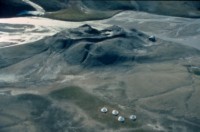The permafrost is thawing
 A pingo is a gigantic blister of ice which arises in the permafrost in connection with a spring. Pingos look like big mounds of gravel, and some have a small tarn or a periodically active spring in their top. The core of the pingo is a large lump of ice. The camp and the hut indicate the scale.
Illustration: Winfried Dallmann, NPI
A pingo is a gigantic blister of ice which arises in the permafrost in connection with a spring. Pingos look like big mounds of gravel, and some have a small tarn or a periodically active spring in their top. The core of the pingo is a large lump of ice. The camp and the hut indicate the scale.
Illustration: Winfried Dallmann, NPI
Why?
Obviously, nothing is going to happen to the bedrock in Svalbard as a result of climate change; extremely high temperatures would be required to achieve that. However, the rise in temperature in the arctic regions does seem to be sufficient to thaw the permafrost.
Permafrost is defined as ground where the temperature is below 0 degrees celsius for minimum two years in succession. To be able to measure this without having to dig into the ground, areas with permafrost generally correspond to areas where the mean annual air temperature is lower than -2 °C. In Svalbard, permafrost is found everywhere except beneath the large glaciers, which provide insulation from the cold so that the ground does not freeze.
The permafrost may be some 100 metres deep on the coast and all of 400-500 metres deep in higher areas. As the soil is not so deep in the Arctic, this means that the bedrock itself is frozen. In summer, the uppermost layer thaws and provides a basis for plants and animals to live in. In Svalbard, this 'active' layer is about 1 metre deep.
What is taking place?
Permafrost that is thawing has impacts on both local and global factors. Thawing changes the vegetation cover and also affects animals that depend upon the vegetation. Wetlands, which are important for several species of birds, may dry out because the permafrost ceases to be a barrier for the surface water, which therefore drains into the ground. Important feeding and breeding sites may disappear. People are affected because roads and buildings founded on permafrost are damaged.
On the global scale, thawing ground will release large amounts of methane (CH4) and carbon dioxide (CO2) which have been frozen into the ground. These gases will exacerbate the greenhouse effect and help to raise the temperatures still more. A warmer climate thus has a self-energising effect.
Did you know...
 The southern boundary for permafrost may move many hundreds of kilometres northwards during this century. If the enormous areas of bog in Siberia and North America thaw, they will release huge amounts of methane and carbon into the atmosphere. The volume of these emissions is difficult to judge, because it will depend on a variety of factors, including the soil moisture.
The southern boundary for permafrost may move many hundreds of kilometres northwards during this century. If the enormous areas of bog in Siberia and North America thaw, they will release huge amounts of methane and carbon into the atmosphere. The volume of these emissions is difficult to judge, because it will depend on a variety of factors, including the soil moisture.